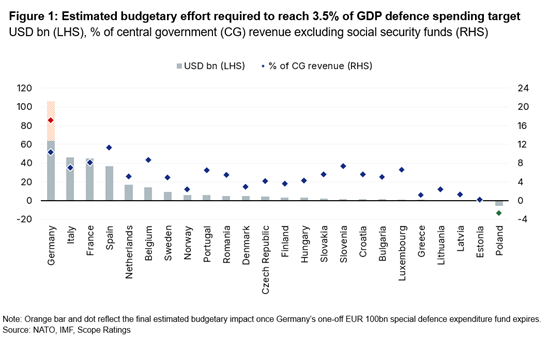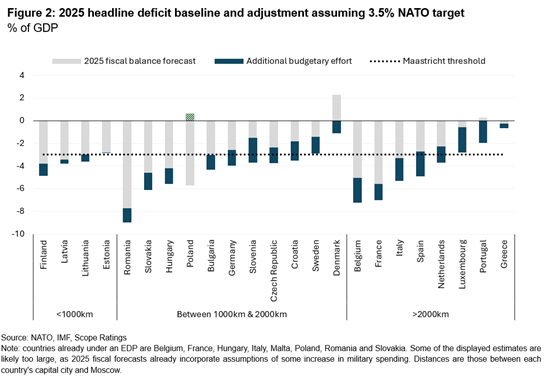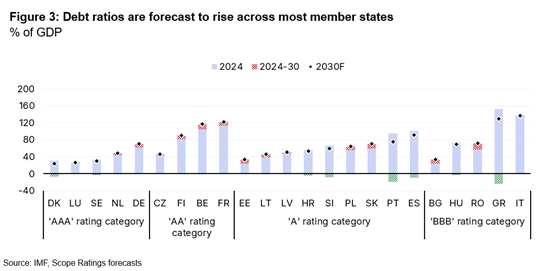Announcements
Drinks
Meeting NATO’s higher defence spending target will weigh on EU credit profiles
By Alvise Lennkh-Yunus, Eiko Sievert, and Brian Marly, Sovereign & Public Sector
NATO’s EU member states will need to allocate, on average, an additional 1.3% of GDP each year to meet the revised defence expenditure of 3.5% of GDP, raising annual defence spending to more than USD 600bn (from about USD 360bn presently). The broader 5% NATO spending target includes 1.5% of GDP expenditure on defence-related infrastructure, networks and industry.
However, the budgetary impact relative to revenues varies widely across countries.
Germany (AAA/Stable) has so far allocated around 10.5% of its budget (1.2% of GDP) towards military spending. To meet the previous NATO target of 2% of GDP, the government relied on a special defence expenditure fund of EUR 100bn agreed in 2022. Following the constitutional amendment of Germany’s debt brake in March 2025, the government will be able to fund higher defence spending through increased debt issuance. Without significant budget re-allocation, this would imply additional borrowing of more than EUR 100bn per year.
If Germany were to finance the additional spending without new debt issuance, the country would face the largest budgetary impact of around 17% of central government revenues. This is considerably higher compared with other large European economies such as France (AA-/Stable, 8%), Italy (BBB+/Stable, 7%) and the United Kingdom (AA/Stable, 3%).
Without the agreed opt-out from the higher spending target, Spain (A/Stable) would have faced the second largest budgetary impact of around 11.4% of central government revenues. Similarly, due to its relatively small military budget, Belgium (AA-/Negative) has also argued for additional flexibility in meeting the new target as the country faces a high budgetary impact of around 8.7% of central government revenues.
In absolute terms, Germany’s defence spending shortfall remains the largest, standing at around USD 106bn per year once the EUR 100bn special defence expenditure fund is depleted, more than twice that of Italy (USD 46bn), France (USD 45bn), the United Kingdom (USD 41bn) and Spain (USD 37bn).

Weaker fiscal metrics impact credit profiles, even if EU fiscal rules eased
Several countries are already struggling to reduce their budget deficits below the 3% of GDP in line with EU fiscal rules (Figure 2). However, greater flexibility in the rules reduces the likelihood of more countries facing excessive deficit procedures (EDP) as a result of higher defence spending.
Still, the additional budgetary burden would significantly raise the hurdle for fiscal consolidation for several countries already under an EDP, including France, Belgium, and Italy.

Conversely, Germany is among the few member states fiscally able to absorb the defence-expenditure shock, together with sovereigns already meeting, or close to the adjusted target (Greece, Poland and the Baltic States) and/or countries with fiscal space such as Portugal and the AAA-rated member states.
The German government intends to increase total federal defence spending to 2.4% of GDP in 2025, gradually rising to 3.5% by 2029. To sustain the higher long-term defence spending target, budgetary adjustments will become necessary to stabilise the public debt trajectory. In the case of Germany, we expect the debt-to-GDP ratio to rise from 63% in 2024 to just above 70% in 2030 (Figure 3).

Pace of increased military spending to vary considerably in Europe
Importantly, our debt forecasts are based on varying rates of increase in defense spending. Governments in the CEE region are expected to accelerate their efforts upfront, while Southern European countries (such as Portugal and Italy) and/or those facing significant fiscal constraints (like Belgium and France) are likely to adopt a more gradual approach. Spain’s decision to opt out of the recent NATO commitment highlights this divergence in threat perceptions.
From a credit rating perspective, any assessment also goes beyond the compliance with fiscal rules. We focus on the country's broader fiscal stance, and thus budget balances, the sustainability of interest payments, and medium-term debt trajectories.
Higher defence expenditure will lead to higher borrowings and deteriorating debt-to-GDP trajectories in most EU countries, and thus weaker sovereign credit profiles, unless governments reduce spending elsewhere or increase revenues.
Financing defence and security emerges at the EU level
Given the limited fiscal space among several EU member states, the financing of security and defence could also shift toward the European level. Centralising EU security and defence financing could provide more sustainable and coordinated financing across member states while also creating economies of scale in defence and security procurement. Such a move would mark a significant political step towards deeper European integration.
To address this issue, the EU (AAA/Stable) has adopted regulation setting up the Security Action for Europe (SAFE) initiative that will provide an additional EUR 150bn line of credit to member states. Funded through EU issued debt, SAFE will offer loans to member states with potential advantages in terms of lower borrowing costs and extended maturities, with loans of a maximum duration of 45 years and a 10-year grace period for principal repayments.
The implementation of this programme is expected to increase EU bond issuance (EUR 662bn as of June 2025) and require a larger share of the EU budget to be spent on interest repayments, especially starting over the next multi-annual financial framework 2028-35.
Other EU initiatives include the European Defence Industry Programme (EDIF), which could provide EUR 1.5bn in grants by end-2027, would focus on improving cross-border cooperation in defence procurement, strengthening defence industry supply chains and increasing manufacturing capacities.
Proposals also include the creation of a dedicated European Rearmament Bank modeled on institutions like the European Bank for Reconstruction and Development (EBRD). This bank would be funded by a coalition of willing states – potentially both EU and non-EU NATO members – which would contribute initial capital, allowing the bank to leverage its capital through bond issuance. The bank could offer lending directly to governments for defence procurement, and to defence companies to expand industrial capacity.
Yet another proposal is the establishment of a broader Defence, Security & Resilience (DSR) Bank, aimed at supporting joint procurement, manufacturing scale-up, and strategic stockpiling across like-minded allies, including transatlantic and Indo-Pacific partners.





